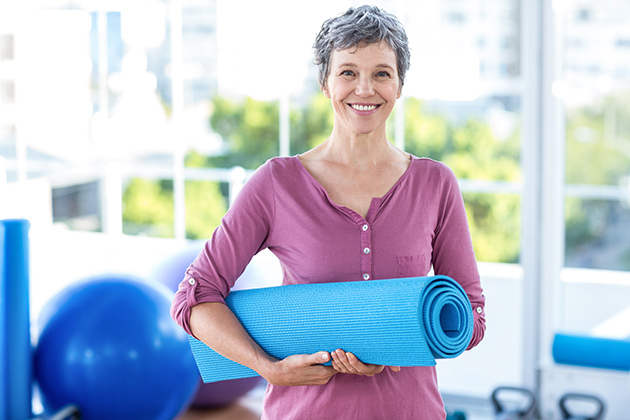
Not only does yoga provide a variety of general health benefits as you age, it can also help ease the symptoms of menopause. You may be experiencing hot flushes, difficulty sleeping or even forgetfulness. While yoga is not a miracle cure (as such a thing doesn’t exist), it can certainly be part of a strategy to help you cope with the symptoms that you may be facing.
Yoga offers many general benefits for those going through menopause, and can be tailored to just about any level of fitness.
General benefits of yoga
Lowers your stress levels
Practicing yoga helps to control breathing, which can also help to lower stress and manage feelings of anxiety. The purpose of yoga is to unite the body and mind, and as such to bring harmony and balance to your lifestyle. While menopause is the moment that menstruation stops, the transition (and menopause-related symptoms) that you experience can last for years. Practicing yoga during this period can help to lower your stress levels and ease the transition. Yoga can also help you to develop coping skills and a more positive outlook.
Good for your joints and back pain
Yoga can help ease joint pain, such as arthritis, and as such can promote great long term health. In addition, it can also lessen lower back pain (see the pose downward facing dog below) by giving your muscles a much needed stretch.
Increased flexibility and strength
Most yoga poses are great for increasing flexibility. This is important during all stages of life, and makes you less prone to injury. In addition, yoga can also increase your strength, which means yoga is a great physical activity, that can improve your overall health. It can also improve your performance in any other sports or activities that you undertake.
Great for overall health and wellbeing
People who exercise as they age are more likely to report better health and general wellbeing. And specifically in relation to yoga, some poses can support a positive mental state. For example, supported backbends can bring a sense of lightness into the body. Chest expanding poses can bring with them a feeling of confidence, countering feelings of depression. As this research article outlined, not only can yoga influence your physical wellbeing, but if practiced with proper guidance it can also influence your emotional wellbeing too, in as little as eight weeks.
It’s natural
It can be done just about anywhere, is relatively cheap (or even free), and best of all, is completely natural! While you can enjoy the benefits of yoga after even a few short weeks of practice, there is no need to endure unwanted side effects, because unlike some medications, there are none. Yoga is a natural way to improve your health and wellbeing, and helps to stabilise your body.
It’s easy to start and is low impact
Unlike some other sports or exercise regimes, it is easy to start yoga. Most poses can be adjusted to suit the individual, meaning that yoga is great for people with a wide variety of fitness levels. In addition, it’s a low-impact activity that won’t strain your joints, and carries a low risk of injury (although beginners should still look to instructors for initial guidance).
Specific yoga poses to benefit menopause
Yoga has the ability to reduce stress, promote a positive attitude and increase wellbeing. It can also help women cope with the symptoms of menopause, and can improve physical and mental health. In addition, there are also specific poses and types of yoga that are particularly well suited for menopausal women.
Restorative and supportive poses provide the most relief for women going through menopause, while some forms of yoga, such as hot yoga, can actually aggravate symptoms. For example, hot flushes and anxiety can actually be increased by undertaking hot yoga. It’s a good idea to focus on poses which reduce tension and grip in the body, and provide support by utilising blocks, towels, pillows and other props.
We recommend you speak with a qualified yoga instructor or your healthcare professional before trying any new exercises.
Supta Virasana (Reclining Hero Pose)
Supta Virasana is a relaxing pose that opens up the chest. If you have back issues, this pose can also be supported through the use of a pillow. Kneel and lean back so that your quads are stretched out. Make sure that your knees and lower back are not hurting, however, and lay your arms by your side (or above your head, like a ‘hero’). This is a pose that will relieve and relax you, and is suited toward countering the irritability and fatigue of menopause. Do not try this exercise if you are unable to easily place your bottom on the floor between your feet.
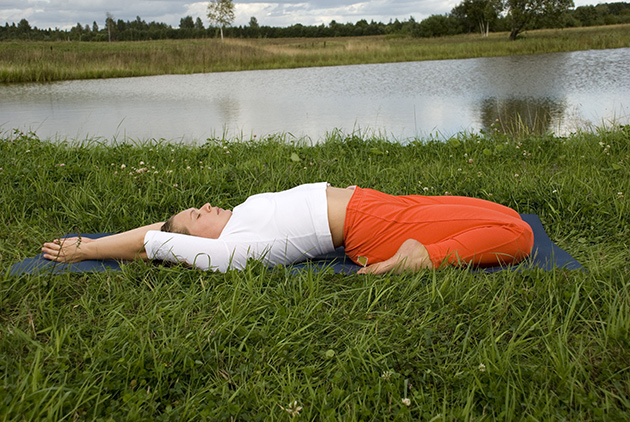
Setu Bandha Sarvangasana (Bridge Pose)
This spine-elongating pose is said to reduce stress, fatigue and insomnia. It’s an intermediate-level pose which involves lying on your back facing the ceiling with arms by your side. Then with your legs roughly shoulder width apart, create a ‘bridge’ by raising the lower half of your body (starting at your hips) so that your back remains straight and stomach firm, and the legs form a 90 degree angle. Hold, then lower back to starting position. Repeat three times.
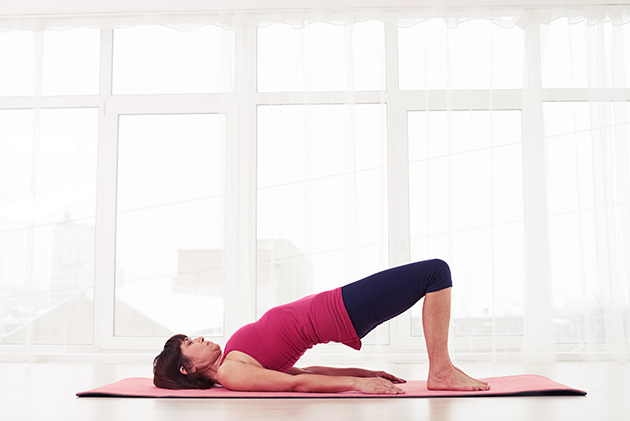
Supta Baddha Konasana (Reclining Bound Angle Pose)
Another great supported backbend, the Supta Baddha Konasana can also help to reduce fatigue. It also has the benefit of improving respiration and circulation, while still providing a lot of support for the body. Start sitting, in a bound angle pose (which means to have your heels pressed together). Bring your heels in close to your pelvis while keeping their edges on the floor. This is a pose in itself. For the reclining version, slowly lean back by first leaning on your hands. Support your head with a roll or bolster if needed.
Uttanasana (standing forward bend)
The standing forward bend stretches the hips and hamstrings. Reach up with one arm, stretching your side for one breath. Lower and repeat on the other side. Start the next part with arms wide open. Then, lean forward from your hips, as you slowly bring your chest towards your knees. Bend your knees slightly and bring your arms in closer so that you are holding each elbow in your hand at the lowest point of the pose. Hold for 45 seconds and then slowly roll back up.
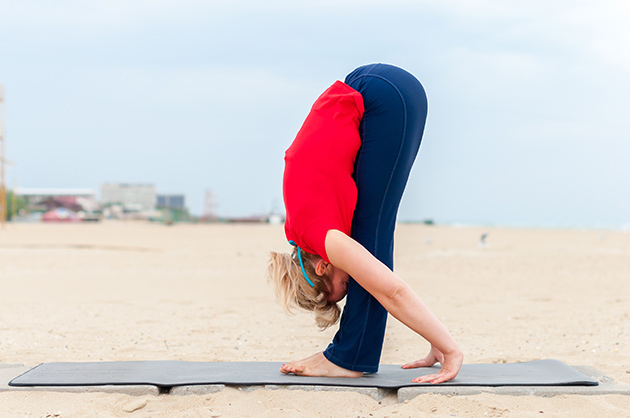
Adho Mukha Svanasana (Downward facing dog)
This pose looks exactly like an inverted V. Kneel down on all fours, then you exhale and raise your butt towards the ceiling. Again, supported poses are ideal for those experiencing menopausal symptoms, so use a pillow to help support your neck rather than letting it hang if it is more comfortable. This pose stretches the upper back and legs, and can help to relieve symptoms of menopause, as well as headaches. Don’t worry if your heels aren’t fully touching the ground, but try and focus on recreating a V.
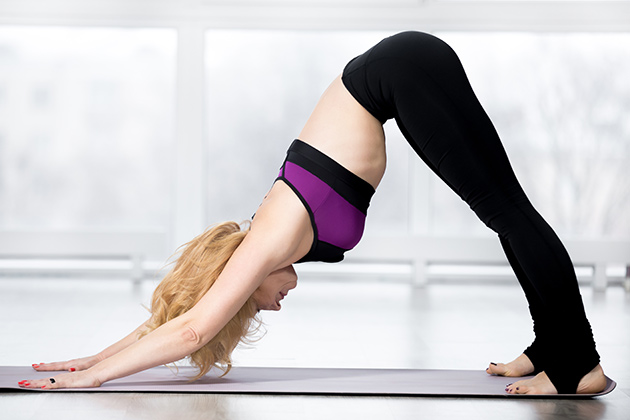
Viparita Karani (Legs up the wall)
This pose uses a wall to support the legs as you lie facing upwards, as well as a pillow or towel under the back for additional support. This is a great and easy beginner exercise that involves forming an ‘L’ against a wall. This is a pose that brings great rejuvenation, and can be held for five to ten minutes. This pose boosts circulation, and is a refreshing pose that can be done just about anywhere, and is an extremely simple pose that brings with it great benefits.
Paschimottanasana (Seated forward bend)
This pose is simple and involves reaching for your toes while sitting. Depending on your level of flexibility, you may be able to reach past your toes and bring your body close to your knees, or alternatively, you may only be able to reach part of the way forward. It’s important not to overexert yourself and stay within your limits.
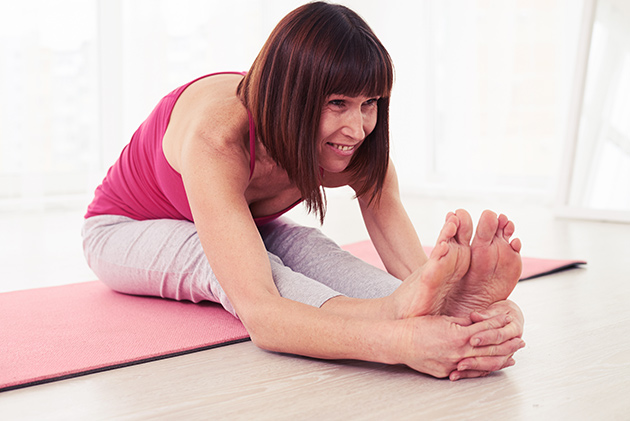
Balasana (Child’s Pose)
Resting in this pose can help reduce menopause hot flushes by cooling down the body and reducing stress. Place your shins on top of a yoga mat, with your knees slightly wider than your hips. Curl the rest of your body down, with arms either out in front of you, or by your side. This is a simple and well known yoga pose that promotes feelings of calm while lightly stretching the legs and back. It’s a great pose that can be used as a gentle break in between other more demanding poses, or if you need a little rest.
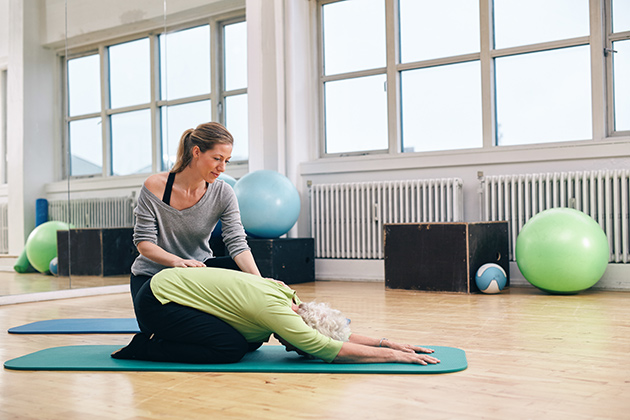
Enjoying the benefits of yoga throughout menopause
By taking the time to relax and reduce stress, your body can have time to recover, setting your heart rate, digestive muscles and nervous system back into balance. In addition to the various health benefits that yoga brings, it is also well suited to women experiencing menopause and can help soothe common symptoms, like hot flushes, anxiety, irritability, insomnia, fatigue, depression, mood swings and memory problems.
While women will experience differing symptoms, and to differing extents, yoga has been shown to consistently have a positive effect on not only overall well being, but the specific symptoms arising from menopause. Focus on practicing well supported and restorative poses, and enjoy the benefits!
For more great advice on how to manage menopause and menopausal symptoms, contact the experts at Australian Menopause Centre today.